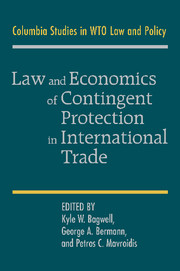Book contents
- Frontmatter
- Contents
- Contributors
- Introduction
- 1 An Overview of the Agreement on Subsidies and Countervailing Measures – Including a Discussion of the Agreement on Agriculture
- 2 Do the World Trade Organization Disciplines on Domestic Subsidies Make Sense? The Case for Legalizing Some Subsidies
- 3 Subsidies and Countervailing Measures: Determining the Benefit of Subsidies
- 4 The Enduring Problem of World Trade Organization Export Subsidies Rules
- 5 The Boeing–Airbus Dispute: A Case for the Application of the European Community State Aid Rules?
- 6 Antidumping: Overview of the Agreement
- 7 Price Differentiation in Antitrust and Trade Instruments
- 8 Nonpreferential Origin Rules in Antidumping Law and Practice
- 9 The Appellate Body Interpretation of “Sunset Reviews” Provisions of Anti-Dumping and Countervailing Measures Agreements: A Critical Analysis
- 10 The Safeguards Agreement – An Overview
- 11 Why Are Safeguards Needed in a Trade Agreement?
- Index
- References
10 - The Safeguards Agreement – An Overview
Published online by Cambridge University Press: 03 May 2010
- Frontmatter
- Contents
- Contributors
- Introduction
- 1 An Overview of the Agreement on Subsidies and Countervailing Measures – Including a Discussion of the Agreement on Agriculture
- 2 Do the World Trade Organization Disciplines on Domestic Subsidies Make Sense? The Case for Legalizing Some Subsidies
- 3 Subsidies and Countervailing Measures: Determining the Benefit of Subsidies
- 4 The Enduring Problem of World Trade Organization Export Subsidies Rules
- 5 The Boeing–Airbus Dispute: A Case for the Application of the European Community State Aid Rules?
- 6 Antidumping: Overview of the Agreement
- 7 Price Differentiation in Antitrust and Trade Instruments
- 8 Nonpreferential Origin Rules in Antidumping Law and Practice
- 9 The Appellate Body Interpretation of “Sunset Reviews” Provisions of Anti-Dumping and Countervailing Measures Agreements: A Critical Analysis
- 10 The Safeguards Agreement – An Overview
- 11 Why Are Safeguards Needed in a Trade Agreement?
- Index
- References
Summary
Introduction
The Agreement on Safeguards (the Safeguards Agreement or SA) establishes rules for the application of safeguard measures, a term understood to mean those measures provided for in Article XIX of the General Agreement on Tariffs and Trade (GATT), entitled “Emergency Action on Imports of Particular Products.” Although the World Trade Organization (WTO) SA was an agreement that did not exist in the form of a plurilateral code prior to the conclusion of the Uruguay Round, it is thus nevertheless clearly rooted in the GATT system and in Article XIX of the GATT in particular. More than with any other of the WTO's Agreements, it is the relationship between the new WTO Agreement on Safeguards and the original “safeguard” provision in the GATT that proved to be problematic.
In this chapter, first, safeguard measures are discussed in the larger context of the WTO system in general and WTO trade remedies in particular. Second, the conditions for the imposition of safeguard measures will be examined. Third, the chapter addresses the application of safeguard measures in place and time, and distinguishes between the various types of measures that may be imposed as a safeguard. Some conclusions are formulated at the end.
Safeguards in the WTO Context
Safeguards as a Trade Remedy
A safeguard measure is a unilateral way of providing additional protection to the domestic industry. In that respect, safeguards are akin to other forms of contingent trade protection, such as antidumping (AD) and countervailing measures (CVMs).
- Type
- Chapter
- Information
- Publisher: Cambridge University PressPrint publication year: 2009
References
- 1
- Cited by



